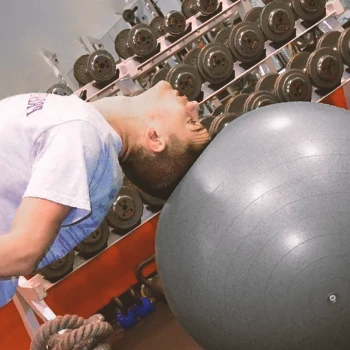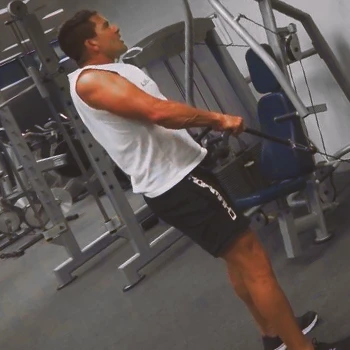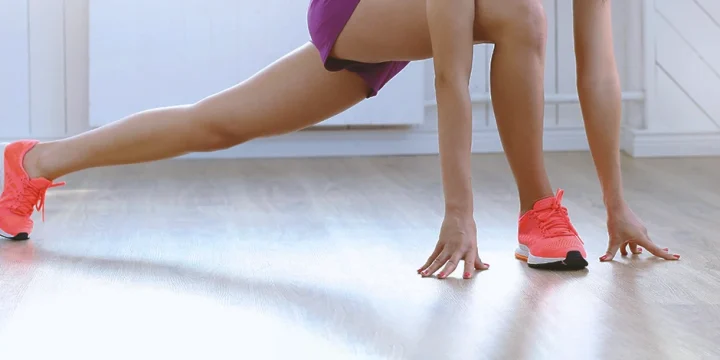The neck is a huge part of a well-rounded physique, and sometimes it is necessary to build strong and functional neck muscles so you can perform big lifts safely without unnecessary injuries.
However, nailing the optimum training volume, which includes reps, sets, resistance, and rest intervals, is something many people get wrong, along with choosing ineffective or even bad neck exercises to perform.
As a certified personal trainer and after conducting 25-hour research and talking to other professionals in the field, I singled out the best neck exercises to build a strong neck, diversify your workout, and increase your overall performance.
After reading the article, you will know how to perform all the exercises properly and structure neck workouts so you never underperform or get injured again.
Quick Summary
- The best neck exercises include stability ball neck bridges, dumbbell shrugs, cable shrugs, resisted neck flexion/extension/lateral flexion, and sitting weighted neck flexion and extension.
- To get the most out of every neck workout, and the same goes for any other type of weight training, you must incorporate the principle of progressive overload, meaning you must increase the overall training volume or intensity for each following workout.
- According to research from the International Journal of Exercise Science, it's essential to allow 2472 hours between neck workout sessions for glycogen super-compensation and central nervous system recovery.
- In my experience, consistency and correct technique in neck exercises are key to achieving lasting strength and flexibility.
The Ultimate Neck Workout

To get the most out of every neck workout, try incorporating the principle of progressive overload each following workout, as recommended by studies published in the National Institutes of Health [1].
According to the International Journal of Environmental Research and Public Health, this will increase the hypertrophy or muscle-building effects and ensure you keep making substantial progress to achieve a thick and functional neck [2].
In my experience as a personal trainer, balancing this with adequate recovery is crucial.
I recommend a rest period of 24-72 hours between workouts for optimal glycogen replenishment and central nervous system recovery, as supported by the International Journal of Exercise Science [3].
"The average human head weighs eight pounds. When you think about it like that, your neck, which is what supports and rotates your head, is pretty darn strong. And just like any muscle — well, the neck is technically made up of many muscles — you can train it to be even stronger and more mobile."
- Shane McLean, Certified Personal Trainer
Stability Ball Neck Bridges

The stability neck bridge, a demanding exercise, requires strong upper traps and ample sagittal plane mobility.
In my coaching experience, it's especially beneficial for office workers with neck pain, as such specific exercises have consistently helped alleviate their discomfort.
How to Perform Stability Ball Neck Bridges
- Place the stability ball on the floor and carefully lie on your back.
- Ensure your feet are firmly placed on the floor, your shoulder blades are on the ball, and you look straight ahead.
- Start the exercise with your chin tucked by performing the maximal neck flexion.
- Slowly initiate the neck extension movement by bringing your head closer to the floor.
- When you reach maximal neck extension, reverse the motion to return your neck to the neutral position and repeat.
- Repeat for 10 reps without external weight with controlled movements.
- Do 4-5 sets, and rest for 90 seconds between the sets.
Dumbbells Shrugs
Dumbbell shrugs will effectively build your trap muscles, which are considered a part of your neck.
How to Do Dumbbell Shrugs
- Pick two dumbbells of appropriate weight so you can perform up to 12 consecutive reps without pausing.
- Assume a hip-width stance with your feet, extend your knees, keep your hips neutral, and look straight ahead.
- Start the exercise by performing shoulder/scapular elevation by shrugging them upward towards the ceiling.
- When you reach the top position where you can’t elevate your scapula anymore, hold it for one second of isometric contraction.
- Reverse the motion by depressing your shoulder blades to return to the starting position.
- Repeat for 12 reps, 4 sets, and rest between 60 and 90 seconds between the sets.
Cable Shrugs

Cable shrugs are also great for making your neck appear more muscular and will build those traps up so you can look bigger and wider.
How to Perform Cable Shrugs
- Load a quality cable machine with sufficient weight to perform up to 12 cable shrugs without resting.
- Assume a hip-width stance with your feet and face the cable machine.
- Pick a t-bar or straight-bar attachment for this exercise.
- Keep your back and head neutral during the whole exercise motion and knees in the fixed position.
- Start the exercise by shrugging your shoulders upward, meaning you must perform scapular elevation.
- After you reach maximal shoulder blade elevation, hold that position for a one-second isometric contraction.
- Reverse the motion by depressing the shoulder blades to the starting position.
- Repeat for 12 reps, 4 sets, and rest between 60 and 90 seconds between the sets.
Resisted Neck Flexion, Extension, and Lateral Flexion
Resisted neck flexion, extension, and lateral flexion are already part of the abovementioned exercise in a way. However, now we are adding external resistance to progressively overload the exercise.
How to Perform Neck Flexion, Extension, and Lateral Flexion
- For this exercise, you will need that special head attachment that can be connected with a band to the pole or squat rack.
- You will perform resisted neck extension, flexion, and lateral flexion in different standing positions.
- You should face the pole where the resistance band is attached for neck flexion and extension.
- For lateral neck flexion, you should turn 90 degrees on one side to follow the neck lateral flexion movement in the frontal plane.
- Turn 180 degrees to perform lateral flexion on the other side of the neck.
- Perform 4 sets, 8 reps, and rest for 90 seconds between the sets.
Sitting Weighted Neck Extensions

Sitting-weighted neck extensions are performed by sitting on the weight bench and attaching the special head equipment where you can place external resistance to move harder.
How to Perform Sitting Weighted Neck Extensions
- Take the necessary head equipment and chains to connect a weight plate, dumbbell, or kettlebell to it.
- Pick lightweight first if you are doing the exercise for the first time.
- Sit on the flat bench and take a wider stance with your legs.
- Start the exercise by performing weighted neck flexion by lowering your head towards the ground.
- When you reach the bottom position, slowly extend your head to return to the neutral position.
- Repeat for 8 reps, 3 sets, and rest for 90 seconds between the sets.
Also, incorporating varied exercises like Pilates or yoga, proven to benefit neck pain and disability, offers a holistic approach to enhancing neck strength and functionality, as I've observed with my clients.
What Muscles Do Neck Exercises Work?
Neck exercises work muscles such as scalene muscles and suboccipital muscles.
In addition, your upper thoracic extensors and the deep cervical flexors will work too.
Specific neck exercises will also target your traps and some other muscles around your neck.
How to Structure Neck Workouts

To structure your neck workout, you must incorporate the principles of hypertrophy training, which are:
- Sets - No less than 3
- Reps - Between 6 and 12
- Rest intervals - Between 30 and 90 seconds
Always select exercises covering all motion planes: sagittal, frontal, and transverse.
Remember, recovery is key; I advise 48–72 hours of rest between neck workouts.
Additionally, for neck pain prevention, especially in sedentary lifestyles or those prone to neck issues, incorporating preventive exercises into your routine is highly effective, as I've seen with many of my clients.
Related Articles:
FAQs
What Is the Most Effective Neck Exercise?
The most effective neck exercise is a weighted neck extension. You can significantly reduce your neck pain and build both anterior and posterior neck muscles if you choose the proper weight and starting position (angle) of the exercise.
How Can I Build My Neck Muscles Fast?
You can build your neck muscles fast by increasing the intensity of direct neck training and eating the right food and supplements. However, to build strength and hypertrophy in major back muscles, you must combine flexion, extension, and lateral neck exercises in all three planes of motion to maximize the results.
Do Neck Exercises Work?
Yes, neck exercises work. You can build a strong and muscular neck by regularly performing neck exercises with proper intensity, volume, and rest intervals.
How Did Mike Tyson Train His Neck?
Mike Tyson trained his neck by performing neck bridges every day. You can easily build major neck muscles by performing neck bridges, just like wrestlers do, but that isn’t the safest and most optimal way to build a little triangular muscle, long slender superficial muscle, and posterior scalene muscles.
Is It Okay to Train Neck Everyday?
It depends on training intensity if it is ok to train your neck daily. You can easily injure your cervical spine and increase daily neck tension by performing too strenuous and challenging neck exercises daily.
References:
- https://www.ncbi.nlm.nih.gov/pmc/articles/PMC4215195/
- https://www.ncbi.nlm.nih.gov/pmc/articles/PMC6950543/
- https://www.ncbi.nlm.nih.gov/pmc/articles/PMC6719818/
About The Author
You May Also Like






